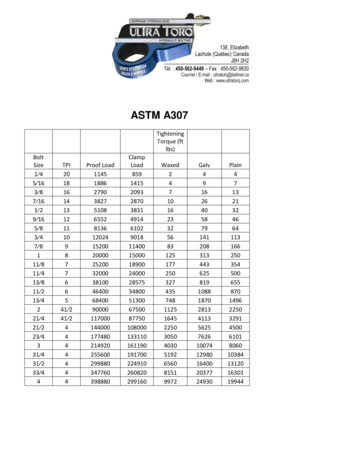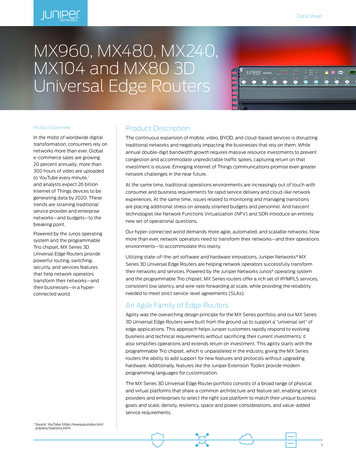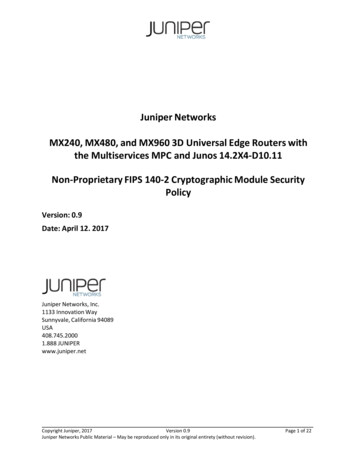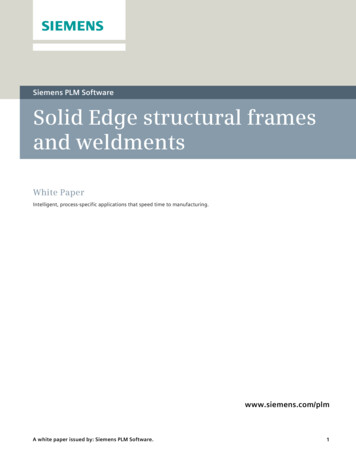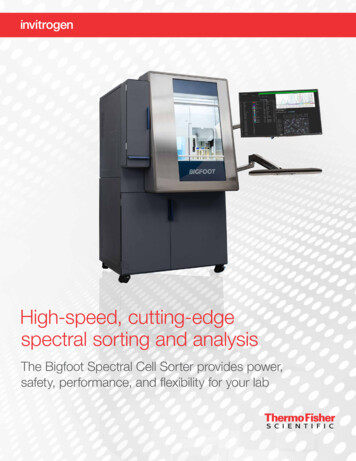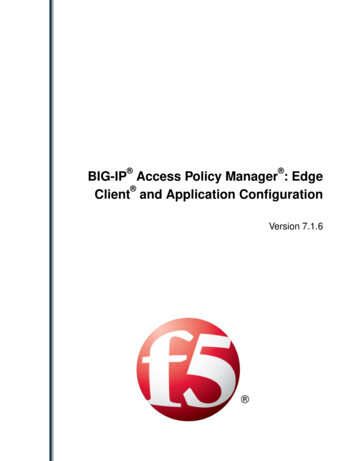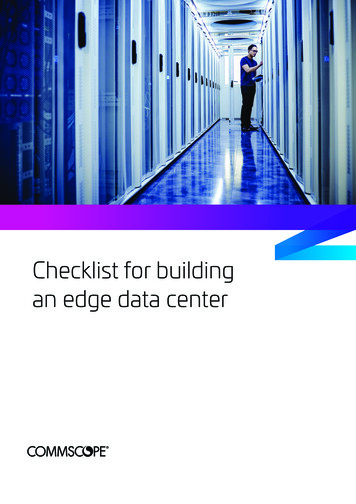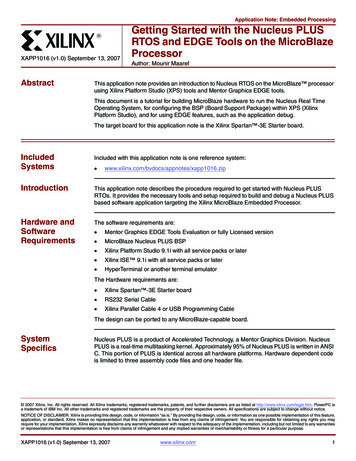
Transcription
Application Note: Embedded ProcessingRXAPP1016 (v1.0) September 13, 2007AbstractGetting Started with the Nucleus PLUSRTOS and EDGE Tools on the MicroBlazeProcessorAuthor: Mounir MaarefThis application note provides an introduction to Nucleus RTOS on the MicroBlaze processorusing Xilinx Platform Studio (XPS) tools and Mentor Graphics EDGE tools.This document is a tutorial for building MicroBlaze hardware to run the Nucleus Real TimeOperating System, for configuring the BSP (Board Support Package) within XPS (XilinxPlatform Studio), and for using EDGE features, such as the application debug.The target board for this application note is the Xilinx Spartan -3E Starter board.IncludedSystemsIncluded with this application note is one reference system:IntroductionThis application note describes the procedure required to get started with Nucleus PLUSRTOs. It provides the necessary tools and setup required to build and debug a Nucleus PLUSbased software application targeting the Xilinx MicroBlaze Embedded Processor.Hardware andSoftwareRequirementsThe software requirements are: www.xilinx.com/bvdocs/appnotes/xapp1016.zip Mentor Graphics EDGE Tools Evaluation or fully Licensed version MicroBlaze Nucleus PLUS BSP Xilinx Platform Studio 9.1i with all service packs or later Xilinx ISE 9.1i with all service packs or later HyperTerminal or another terminal emulatorThe Hardware requirements are: Xilinx Spartan -3E Starter board RS232 Serial Cable Xilinx Parallel Cable 4 or USB Programming CableThe design can be ported to any MicroBlaze-capable board.SystemSpecificsNucleus PLUS is a product of Accelerated Technology, a Mentor Graphics Division. NucleusPLUS is a real-time multitasking kernel. Approximately 95% of Nucleus PLUS is written in ANSIC. This portion of PLUS is identical across all hardware platforms. Hardware dependent codeis limited to three assembly code files and one header file. 2007 Xilinx, Inc. All rights reserved. All Xilinx trademarks, registered trademarks, patents, and further disclaimers are as listed at http://www.xilinx.com/legal.htm. PowerPC isa trademark of IBM Inc. All other trademarks and registered trademarks are the property of their respective owners. All specifications are subject to change without notice.NOTICE OF DISCLAIMER: Xilinx is providing this design, code, or information "as is." By providing the design, code, or information as one possible implementation of this feature,application, or standard, Xilinx makes no representation that this implementation is free from any claims of infringement. You are responsible for obtaining any rights you mayrequire for your implementation. Xilinx expressly disclaims any warranty whatsoever with respect to the adequacy of the implementation, including but not limited to any warrantiesor representations that this implementation is free from claims of infringement and any implied warranties of merchantability or fitness for a particular purpose.XAPP1016 (v1.0) September 13, 2007www.xilinx.com1
RSystem SpecificsNucleus PLUS RTOS CharacteristicsSome of the Nucleus PLUS RTOS characteristics are listed below. Small footprint High speed, multi-tasking kernel Scaleable hard real-time kernel Priority, pre-emptive scheduler Inter-task communication Inter-task synchronization memory management Dynamic creation and deletion of all objectsNucleus PLUS RTOS ComponentsThe main components of Nucleus PLUS are listed below. Common Services (CS) Initialization (IC) Thread Control (TC) Timer (TM) Mailbox (MB) Queue (QM) Pipe (PI) Semaphore (SM) Event Group (EV) Partition Memory (PM) Dynamic Memory (DM) Input/Output Driver (IO) History (HI) Error (ER) License (LI) Release (RL)Nucleus PLUS RTOS ArchitectureNucleus PLUS RTOS requires a periodic interrupt to provide time-oriented services such astime-slicing, service call time outs, and application timers. The default setup for the timerinterrupt is set up on a 10 ms period.The Nucleus RTOS is designed to be used as a C library. Nucleus services used inside the SWapplication are extracted from the PLUS library and combined with the application objects toproduce the complete executable image. All files that access Nucleus PLUS services mustinclude the header file nucleus.h. The Application Initialize function is the starting point ofthe user SW application.Nucleus PLUS defines several standard data types in the include file nucleus.h. These datatypes are guaranteed to remain common across platforms by assigning the appropriate basicdata type of the target C compiler. This allows PLUS to perform in an identical manner onmultiple platforms.2www.xilinx.comXAPP1016 (v1.0) September 13, 2007
Installing the EDGE Environment and MicroBlaze BSPRNucleus PLUS Integration in Xilinx EDKAs the use of Xilinx FPGAs in embedded systems grows, the need to facilitate the integration ofthe RTOS Design Flow into the FPGA design cycles increases.Xilinx provides the EDK (Embedded Developers Kit) Tools with an XPS (Xilinx Platform Studio)user interface. The Embedded Development Kit (EDK) bundle is an integrated software solutionfor designing embedded processing systems. This pre-configured kit includes the PlatformStudio tool suite (XPS) along with the documentation and IP that are required for designingXilinx Platform FPGAs with embedded PowerPC hard processor cores and MicroBlaze softprocessor cores, or both.The Microprocessor Library Definition (MLD) Technology is used for auto-customization oflibraries and Board Support Package (BSPs). It is a data-driven process based on usersupplied configuration parameters. It supports the specification of specific HW requirements forany SW services support which is a new data-driven capability that generates the RTOS BSPtailored to the defined HW platform.Xilinx EDK includes the device driver library definition for commercial RTOS, such as Nucleus.Nucleus provides a device driver abstraction layer for EDK supported IP peripherals.Based on the user specification, EDK (specifically LibGen Tools in XPS) generates a NucleusBSP corresponding to the hardware platform design.Installing theEDGEEnvironmentand MicroBlazeBSPMentor Graphics EDGE Tools OverviewThe Mentor Graphics Embedded Developers Graphical Environment (EDGE) Tools is acomprehensive embedded tools environment based on Eclipse.EDGE provides specialized Perspectives such as the Project Perspective which is a fullyfeatured project management solution, a builder with support for multiple tool chains, andsource control, including Debug Perspective.This provides a fully featured debugger with kernel awareness tailored for embeddedapplications, including Profiler Perspective, a feature rich source profile.Getting the Nucleus PLUS BSP for MicroBlazeThe Nucleus BSP for MicroBlaze is provided by Mentor Graphics and it is available from MentorGraphics web site at:http://www.mentor.com/products/embedded software/cpu/lv reg.cfmGetting the EDGE Tools Evaluation Version for MicroBlazeMentor Graphics provides an evaluation version of the EDGE Tools for MicroBlaze which candownloaded from the Mentor Graphics web site at:http://www.mentor.com/products/embedded software/development tools/nuc edge/evaluate.cfmInstalling the EDGE Evaluation Version Tools and its LicenseOnce the request for access to the EDGE Tools has been done, a confirmation E-mail whichincludes a license.zip archive is sent. To install, use the following steps.1. Extract the license.zip archive to a directory.2. Copy demo license.txt to the root directory of the downloaded and extracted EDGEinstallation files.3. Launch the EDGE Tools setup.exe installer and follow the instructions to install the EDGETools.XAPP1016 (v1.0) September 13, 2007www.xilinx.com3
RInstalling the EDGE Environment and MicroBlaze BSPAn evaluation license is installed and configured by the EDGE installer.When Nucleus EDGE is launched for the first time, the required tools (Xilinx GNU MicroBlazeToolset v9.1) must be enabled in Nucleus EDGE preferences.Under the Windows Preferences menu, select Nucleus EDGE Builder Toolsets and enablethe appropriate check box. Confirm the setup by clicking OK.Installing Nucleus PLUS BSP for MicroBlazeThe zip file, nucleus xilinx microblaze lv.zip, contains an auto installer of theNucleus PLUS BSP builder and the required Nucleus PLUS LV Library for MicroBlaze.Unzip the File to a temporary directory and run the executable to install the Nucleus PLUS BSPfor MicroBlaze.The Nucleus PLUS LV is a fully-functional version of the RTOS compiled into a library format(rather than the normal source code distribution) with a single restriction — it will stop workingafter 60 minutes, thus facilitating the evaluation of its full functionality.With the purchase a full license of Nucleus PLUS from Mentor Graphics, the full source codewith no run time restriction is provided.The LV of Nucleus PLUS RTOS is configured to execute from the off-chip SRAM orSDRAM/DDR module.Once a full license for the RTOS is available, it can be configured to run from any memory in thesystem.The LV of other Nucleus products provided with EDK 9.1i consists of fully functional productcompiled into a library format.Nucleus products contain robust support of Xilinx MLD technology. With the Nucleusevaluation, all configuration options within the Library/OS Parameters in the Software PlatformSettings dialog may not be functional. This restriction is removed when the full version ispurchased.4www.xilinx.comXAPP1016 (v1.0) September 13, 2007
RCreating a MicroBlaze System to run Nucleus RTOSOnce the Nucleus PLUS LV BSP builder has been run, it will install the necessary Tools into the\edk user repository\.Figure 1 shows the layout of the created directories under:\edk user repository\Nucleus\bsp\nucleus v1 15 a\X1016 01 091207Figure 1: Nucleus PLUS LV BSP Directory LayoutCreating aMicroBlazeSystem to runNucleus RTOSUsing the XPS Base System Builder to create the Embedded SystemThe FPGA based Embedded System consists of the following HW Peripherals:. MicroBlaze processor with 8 Kbyte instruction and data caches 8-KB Local on-chip memory (LMB) shared between the instructions and data sides of theMicroBlaze processor An OPB MCH controller for the on-board DDR SDRAM An OPB EMC controller for the on-board flash memory An OPB timer An OPB UART as input/output user interface An OPB interrupt controller An OPB MDM with an FSL connection to MicroBlaze for the system debugTo design the above system with EDK, the Base System Builder of XPS is used as describedby Figure 4 through Figure 17.Figure 4 shows how to launch the BSB Wizard.XAPP1016 (v1.0) September 13, 2007www.xilinx.com5
RCreating a MicroBlaze System to run Nucleus RTOSWhen XPS is first launched, click on OK in Figure 2 to launch the BSB.If XPS is already open, select File from the XPS menu, then New Project to launch the BSBWizard.X1016 02 091207Figure 2: Launching the BSB WizardFigure 3 shows how to start the design using the BSB Wizard.X1016 03 091207Figure 3: Starting the Nucleus PLUS HW Platform design using the BSB6www.xilinx.comXAPP1016 (v1.0) September 13, 2007
RCreating a MicroBlaze System to run Nucleus RTOSFigure 4 illustrates how to select the Spartan3E Starter Board as a target board.X1016 04 091207Figure 4: Spartan-3E Starter Board Selection in the BSB WizardXAPP1016 (v1.0) September 13, 2007www.xilinx.com7
RCreating a MicroBlaze System to run Nucleus RTOSFigure 5 shows how to configure the MicroBlaze processors and some of the system features.X1016 05 091207Figure 5: Setting up the MicroBlaze Soft Processor8www.xilinx.comXAPP1016 (v1.0) September 13, 2007
RCreating a MicroBlaze System to run Nucleus RTOSFigure 6 shows how to select the OPB UART Lite peripheral and setup its parameters.X1016 06 091207Figure 6: OPB UART Lite Selection and SetupXAPP1016 (v1.0) September 13, 2007www.xilinx.com9
RCreating a MicroBlaze System to run Nucleus RTOSFigure 7 illustrates how to select the OPB EMC to interface to the flash memory.X1016 07 091207Figure 7: OPB EMC Selection10www.xilinx.comXAPP1016 (v1.0) September 13, 2007
RCreating a MicroBlaze System to run Nucleus RTOSFigure 8 shows how to select the MCH OPB DDR peripheral to interface to the DDR SDRAMMemory.X1016 08 091207Figure 8: MCH OPB DDR Controller SelectionXAPP1016 (v1.0) September 13, 2007www.xilinx.com11
RCreating a MicroBlaze System to run Nucleus RTOSFigure 9 shows how to add the OPB Timer to the system.X1016 09 091207Figure 9: Adding the OPB Timer to the System12www.xilinx.comXAPP1016 (v1.0) September 13, 2007
RCreating a MicroBlaze System to run Nucleus RTOSFigure 10 shows how to configure the OPB timer.X1016 10 091207Figure 10: Configuring the OPB TimerFigure 11 shows how to setup the MicroBlaze caches.A Cache Size of any allowed value can be selected depending on the SW Application needsand the available BRAM resources in the target FPGA.X1016 11 091207Figure 11: Configuring the MicroBlaze CachesXAPP1016 (v1.0) September 13, 2007www.xilinx.com13
RCreating a MicroBlaze System to run Nucleus RTOSFigure 12 shows the BSB generated system.X1016 12 091207Figure 12: BSB Generated SystemConfiguring the generated System in XPSAt this stage, the required HW design to run the Nucleus PLUS RTOS based applications SWis almost finished. To decrease the download time of the SW application images via the JTAGcable to the system main memory, an optional FSL (Fast Simplex Link) can be added to thesystem. This FSL Link is a point to point connection between the MicroBlaze soft processor andthe OPB MDM peripheral.XPS is used to add the download FSL Link and to customize some other features of theMicroBlaze soft processor.14www.xilinx.comXAPP1016 (v1.0) September 13, 2007
RCreating a MicroBlaze System to run Nucleus RTOSThis download feature is enabled in the MicroBlaze soft processor by adding a Slave FSLinterface to the core as shown by Figure 14.Figure 13 shows how to customize the MicroBlaze soft cor
Once the Nucleus PLUS LV BSP builder has been ru n, it will install the nec essary Tools into the \edk_user_repository\. Figure 1 shows the layout of the created directories under: \edk_user_repository\Nucleus\bsp\nucleus_v1_15_a\ Creating a MicroBlaze System to run Nucleus RTOS Using the XPS Base System Builder to create the Embedded System

